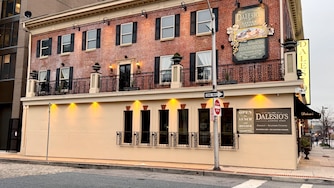Baltimore County is full of history moments that contribute to the story of America.
It was a steppingstone for people like Thurgood Marshall, who tried integrating a Black student to the then-all-white Catonsville High School before the Brown v. Board of Education decision; pit stops for Presidents Richard Nixon and John F. Kennedy before they took over the White House, and the birthplace of Benjamin Banneker.
It was also where public lynching took place during an era when accusations of Black-on-white assault were common, where German and Italian prisoners were kept during World War II, and where World War II and Vietnam-era planes were housed.
Multiple examples of the county’s national historical significance are documented in “Baltimore County: Celebrating a Legacy 1659-2009″ by Barry A. Lanman, published by the Historical Society of Baltimore County.
Here are some moments and landmarks that stand out.
Catonsville High School
Margaret Williams, a Black student who lived in Cowdensville in the 1930s, wanted to attend Catonsville High School for its curriculum. But Black students weren’t allowed. Thurgood Marshall, who would later become the first Black U.S. Supreme Court justice, represented Williams in a court case, arguing that she should attend. He lost the case in 1939. However, he was successful in 1954 when he argued that racial segregation of schools was unconstitutional in the landmark Supreme Court case, Brown v. Board of Education.
Benjamin Banneker
Known for his knowledge in history, math and science, Benjamin Banneker was born and died in Baltimore County. According to “Baltimore County: Celebrating a Legacy,” Banneker was born in an area that would later become Ellicott’s Mills on Nov. 9, 1731. He died in Oella on Oct. 9, 1806. Considered the first Black scientist, Banneker spent his life as a free man during the era of slavery. He was a technical assistant working on the first survey of what would become Washington, D.C., developed expertise in astronomy and was a champion of abolishing slavery and establishing civil rights. Benjamin Banneker Historical Park and Museum is located at 300 Oella Ave. in Catonsville.
Martin State Airport
Planes flown during World War II were created at the Glenn L. Martin plant. Martin moved to the county in 1928, bought 126 acres in Middle River and “built some of the most modern aircraft manufacturing facilities of its time,” according to “Celebrating a Legacy.” The company produced over 80 different types of aircraft and 11,000 planes. Before 1995, it created missiles and aerospace components. Some of the planes built were B-26 Marauders used during World War II and the B-57 Canberra used during the Vietnam War. The Glenn L. Martin Maryland Aviation Museum is located in Middle River at 701 Wilson Point Rd.
Lynching in Towson
In front of the Baltimore County Jail in Towson is a blue marker to commemorate the lynching of Howard Cooper in 1885. He was part of a national trend of Black men and teens who were accused of sexually assaulting or raping white women and then publicly hanged by a mob. Cooper was 15 when he was accused of raping a white woman near Rockland, according to the Equal Justice Initiative.
“An all-white jury sentenced Howard to death, even though the victim never testified that she was assaulted,” the EJI site stated. “The jury never left the courtroom, reaching its verdict in less than a minute.”
Cooper was sentenced to death. But before his execution, 75 men stormed the jail, dragged Cooper from his cell and hanged him from a sycamore tree nearby. Pieces of the rope were given away as souvenirs.
Visits from future presidents
When Nixon was a vice presidential candidate, he gave a campaign speech in Dundalk on Oct. 3, 1952. It wasn’t new territory for him. He lived in Middle River at 900 Wilson Point Rd. for a short time after World War II while he was in the Navy. President Kennedy also gave a speech in the county at Towson Plaza in 1960, two months before he beat Nixon in the presidential election.
Prisoners of war
German and Italian prisoners of war were housed at local prison camps in Baltimore County, according to Lanman. The book notes that the prisoners worked on Catonsville farms until the end of World War II, were treated well and none escaped or caused disruption. It’s unclear where exactly the prisoners were kept in the county, but many Italian and German POWs were also kept at Anne Arundel County’s Fort Meade.
Fitzgerald’s house fire
F. Scott Fitzgerald, author of “The Great Gatsby,” lived in a home called La Paix in Towson off York Road with his wife, Zelda. But the home burned down in 1933. Afterward, the couple moved to 1307 Park Ave. in the city. They were in the region while Zelda was being treated for mental health issues at the Phipps Psychiatric Clinic at Johns Hopkins Hospital and Sheppard Pratt Hospital. It was in Baltimore that Fitzgerald finished his fifth novel, “Tender is the Night.”
kristen.griffith@thebaltimorebanner.com
Read More:



Comments
Welcome to The Banner's subscriber-only commenting community. Please review our community guidelines.